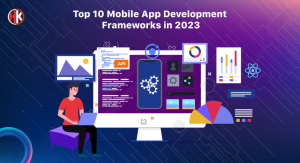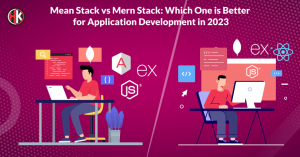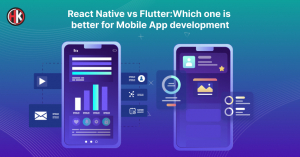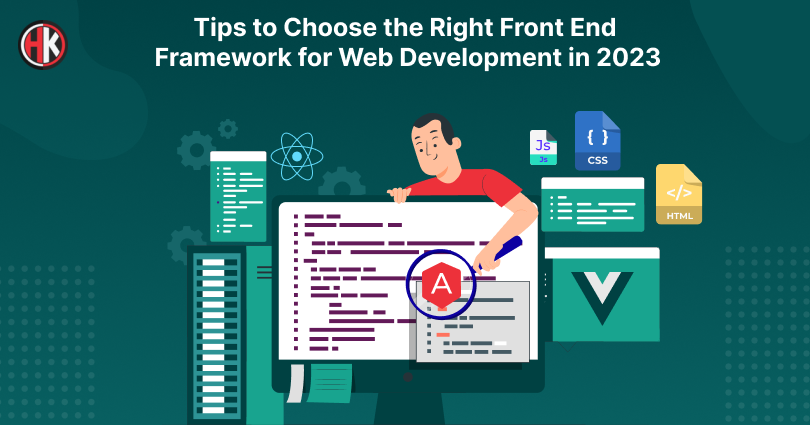
Having a great website is very important for a business to succeed in today’s digital world. The website is often the first thing people see when they learn about your business, so it’s important that it’s easy to use, looks good, and works well.
One of the keys to making this happen is choosing the right framework for building the website or application. A framework is like a basic structure that helps developers create a responsive and interactive design for a website or web app. With so many options available, it can be hard to decide which one to use.
In this post, we will give some tips to help you make a good decision and pick the right framework for your business needs. We will talk about the different features of each framework, as well as the size and goals of your project.
This will help you choose a framework that will help make your website great. So, let’s start exploring the world of front-end frameworks and how they can help make your business even better.
Table of Contents
What is Front end Framework?
Front-end technologies are the tools, languages, and frameworks that are used to make the look and feel of a website or application.

These technologies include HTML, CSS, and JavaScript, which help to create the layout, design, and how the website works. There are various frameworks such as React, Angular, and Vue.js, which make it easier to create complex web pages and user interfaces.
A front-end framework is like a pre-made code that acts as a base for building web applications. It gives a structure for the layout, design, and how the website works and can make it easier to create complex web pages and user interfaces.
Read our New Blog:- How Much Does it Cost to Build an Educational App in 2023
Benefits of Choosing the Right Front end Framework for Web Development:
Choosing the right front-end framework for web development can bring a host of benefits for front-end developers and businesses. Some of the key benefits include:
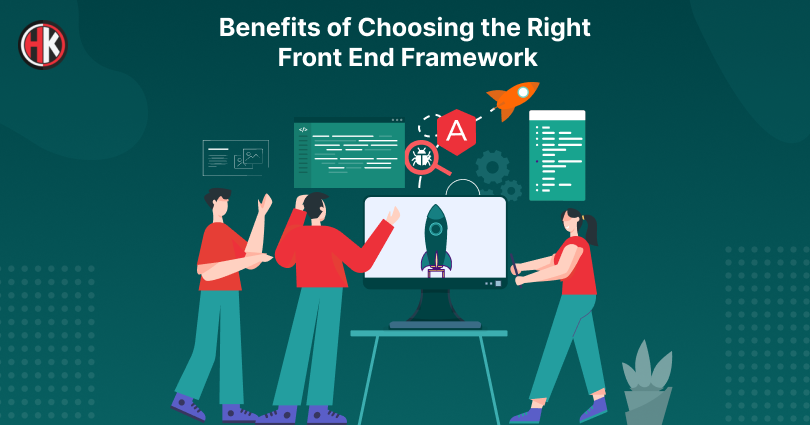
1. Improved Productivity
Front-end frameworks provide developers with pre-built components and tools that they can use to speed up the development process. This means that a website or web application can be built faster and at a lower cost.
2. Consistency
Frameworks provide a consistent structure and design, which ensures that the website or web application is visually cohesive and easy to use.
3. Better User Experience
By using a web development framework, developers can create a website or web application that is easy to navigate, visually appealing, and responsive across different devices.
This improves the overall user experience and increases the chances of visitors staying on the website longer.
4. Cross-browser compatibility
Many front-end frameworks come with built-in cross-browser compatibility, which means the website or web application will work seamlessly on different browsers, including older ones.
5. Better Scalability
Front-end frameworks are designed to handle large and complex web applications, making it easy to scale up or down as the business needs change.
6. Improving User Experience
By using a front-end framework, developers create a web application that is easy to navigate, visually appealing, and responsive across different devices. This improves the overall user experience and increases the chances of visitors staying on the website longer
7. Speed and Efficiency:
Frameworks give programmers access to pre-made tools and components that they can utilize to expedite the development process. This implies that a website application can be created more quickly and for less money.
Read More:- MEAN Stack vs MERN Stack: Which one is Better for app development?
Factors to Consider while Choosing the Best Framework for Development:
Choosing the best framework for web development can be a difficult task, but it is important to consider the following factors to ensure that you select the right one for your project.

Scalability:
The framework should be able to handle increasing workloads and support future expansion.
Performance:
The framework should have good performance and be able to handle a large number of requests and data efficiently.
Development Time:
The framework should be easy to learn and use and have a large developer community to support development and troubleshooting.
Security:
The framework should have built-in security features and be regularly updated to address new security threats.
Maintainability:
The framework should have a clean and modular architecture, making it easy to maintain and update.
Compatibility
The framework should be compatible with the programming languages, databases, and other tools used in the development process.
Popularity
The framework should be widely used, which will make it easier to find developers with experience working with it, and a larger community means more resources and libraries available.
Cost
The framework should be cost-effective and not require expensive licensing or support costs.
Read More:- Node.js vs Java: What Should you Choose for Web Development
Most Popular Front end Frameworks for Web Development in 2023:
The front-end framework landscape is constantly evolving, and it can be difficult to keep up with the latest trends and technologies. However, the following list comprises the most popular front-end frameworks for web development in 2023
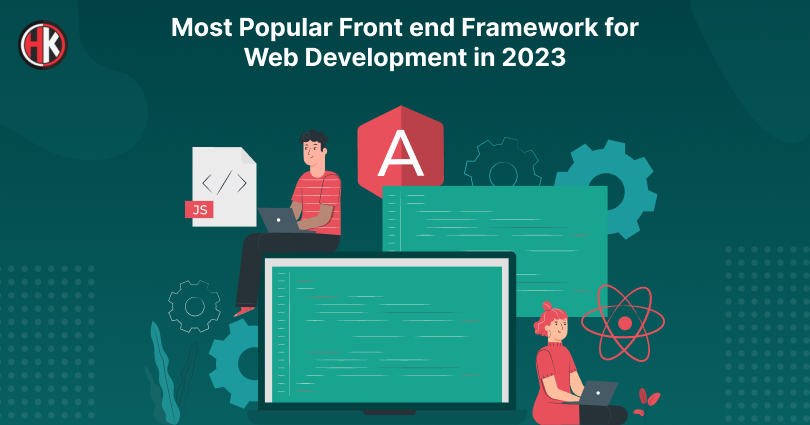
1. Angular
Angular is a powerful front-end technology developed by Google that is designed for building large-scale web applications. It uses a component-based architecture, which allows developers to easily reuse and combine components to build complex user interfaces.
Angular offers advanced features such as two-way data binding which makes it easier for developers to create interactive and responsive web applications. As a business owner, choosing Angular for your web development project can bring a bunch of benefits.
Firstly, Angular’s component-based architecture ensures that your web application is easy to maintain and scale, which can save you time and money in the long run.
Additionally, Angular’s advanced features can help to improve the overall user experience of your web application, which can increase customer engagement and ultimately boost your revenue.
This framework also has a large and active community of developers, which means that you can easily find developers with the necessary skills to build and maintain your web application.
Limitations of Angular
- Angular’s two-way data binding can lead to performance issues when working with large amounts of data.
- Angular is a feature-rich framework that offers a wide range of options for building complex applications.
2. Flutter:
Flutter is a free and open-source mobile application development framework created by Google. It uses the Dart programming language and is based on the concept of reactive programming, which allows for building high-performance, expressive, and responsive user interfaces.
Flutter enables developers to build high-quality apps for both iOS and Android platforms with a single codebase, which can save time and resources. Flutter also provides a wide range of customizable widgets, which allows developers to build unique and visually pleasing user interfaces.
Limitations of Flutter
- The apps developed using Flutter are larger than the apps developed using other frameworks, which can be an issue for users with limited storage space on their devices.
- Flutter is primarily designed for mobile app development, and while it can be used to build web apps, the support is still in beta and not fully mature.
3. Vue.js:
Vue.js is a popular front-end framework for web development that is gaining popularity among developers. It is lightweight, easy to learn, and similar to React and Angular in terms of functionality.
It is known for its simplicity and small learning curve, making it an ideal choice for developers who are new to front-end web development or who want to quickly build web applications.
You can benefit from using Vue.js in several ways. First, it can save time and money on development costs. As a lightweight framework, it is faster to learn and implement than some of the more complex frameworks, which means that projects can be completed in less time.
Additionally, because it is easy to learn, it can be a cost-effective option for businesses that want to build their web applications without having to hire expensive developers.
Secondly, it can help improve the user experience of your website, by providing developers with the tools to create responsive and interactive designs that are easy to navigate. Lastly, as it is gaining popularity, it will make it easier to find developers who are experienced in using Vue.js.
Limitations of Vue.js:
- Vue.js, being highly sought after in China, has a significant portion of its documentation written in Chinese, which can create difficulties for those accessing the documentation outside of China.
- Vue.js is a relatively new framework and as such, it does not have a large community of developers.
- Vue.js has a wide range of features, but it is not as extensive as React or Angular.
4. Ember.js:
Ember.js is a popular front-end framework that is widely used in enterprise web development. This framework is known for its ability to build complex web applications with a high level of scalability and reliability.
Ember.js offers a set of powerful tools and features that make it easy for developers to create highly responsive and interactive web applications. Ember.js can be an optimal option for constructing web applications that demand high efficiency, adaptability, and stability.
Ember.js’s powerful features and tools can help your development team build an application that is responsive and interactive, which can help increase customer engagement and retention.
Additionally, Ember.js means that the framework is constantly updated and improved, ensuring that your application stays secure and up-to-date.
Limitations of ember.js:
- Ember.js has a steep learning curve, which can be challenging for developers who are new to the framework.
- The syntax of Ember.js is quite complex, which can make working with it frustrating at times.
- Using Ember for small applications may feel like overkill and not the best use of the framework.
5. Backbone.js
Backbone.js is a lightweight front-end framework that is known for its simplicity and flexibility. It is popular among developers who prefer a minimalistic approach and want to build web applications with a small footprint.
Backbone.js is based on the Model-View-Controller (MVC) architecture, which helps to organize and structure the codebase, making it easy to maintain and scale.
Backbone.js can be an attractive option for web development projects that require a simple and lightweight solution. It is particularly useful for creating small to medium-sized web applications, as it is easy to learn and implement.
Additionally, Backbone.js is compatible with other libraries and frameworks, which makes it easy to integrate with existing systems.
Limitations of Backbone.js :
- The architecture of Backbone.js can be somewhat ambiguous, which can make it difficult to understand.
- Developers may need to write more code when working with Backbone.js.
- Backbone.js needs to be upgraded regularly to keep up with evolving technology and needs.
6. Svelte:
Svelte is a front-end framework that is gaining popularity among developers. It is known for its small bundle size and ability to create highly responsive web applications.
As a business owner, this means that your website or web application will load faster, providing a better user experience for your customers. Svelte’s small bundle size also means that it uses less bandwidth, which can help to reduce hosting costs.
In addition to its performance benefits, Svelte is also easy to learn and use. It uses a unique approach to building web applications, which can make it a cost-effective choice.
It does not require as much developer expertise as some of the other popular front-end frameworks, which can make it a more budget-friendly option for businesses.
With Svelte, you can expect to get a high-performing and responsive web application that can be built at a lower cost, which is beneficial for any business owner.
Limitations of Svelte
- Svelte has limited availability of technical support and tutorials, which can make it difficult for developers to learn and use.
- The ecosystem of Svelte is small and limited in comparison to other frameworks.
- Svelte has limited tooling options and is not as popular among developers as other frameworks.
7. Meteor
It is a full-stack JavaScript framework that developers widely use to create web applications. It allows developers to use one language, JavaScript, throughout the entire web development process, making it easier to build web applications.
Meteor is known for its ability to build real-time web applications, which allows for instant updates and interactions for users. This makes it a great choice for businesses that need to keep their customers engaged and informed in real-time.
One of the main advantages of Meteor is that it allows for a faster development process. Meteor comes with a set of pre-built tools and packages that developers can use to speed up the development process. This means that you can have their web applications up and running faster, which can save them time and money.
Additionally, Meteor’s real-time capabilities can help keep customers engaged and informed, which can lead to increased customer satisfaction and retention.
Limitations of Meteor.js:
- Meteor.js may not be suitable for large-scale applications due to its limitations in scalability.
- Meteor.js requires a specific file structure and conventions, which can make it less flexible than other frameworks.
Read More:- React Native vs Flutter: Which One is Better for Mobile App Development
How Hackerkernel can help you with your Web Application Development?
HackerKernel offers various web application development services that can help your business grow. Whether you need a basic website, an e-commerce platform, or a complicated web application, we have the necessary skills and knowledge to deliver a high-quality product that suits your requirements.

Our team of skilled developers is proficient in the latest technologies and frameworks such as Angular, Flutter, and Node.js. We use these tools to design robust and scalable web applications that can handle high traffic and complex features.
Our developers also have expertise in responsive design, which enables them to create websites and applications that look great on all devices.
We understand the significance of delivering on time and within budget, that’s why we use an agile development method that allows us to adapt to changes and deliver a product that meets your needs.
Our team is also dedicated to providing exceptional customer service and will work closely with you throughout the development process to ensure that your vision is accomplished.
Conclusion
Choosing the right front-end framework for web development in 2023 can be a daunting task. However, by considering factors such as the project’s requirements, the size, and complexity of the project, the developer’s expertise and experience, and the ongoing support and development of the framework, you will be able to make a well-informed decision that can ensure the successful outcome of your project.
It is crucial to remember that the technology and tools used for front-end development are constantly changing and evolving. This means that what is considered to be the best framework or library at one point in time may not necessarily be the best choice in the future.
Frequently Asked Questions(FAQ)
1. Which Front end framework is faster?
The speed of a front-end framework can depend on various factors such as the size and complexity of the project, the developer’s expertise and experience, and the ongoing support and development of the framework.
Some frameworks that are known for their performance and speed include React, Vue.js, and Svelte.
2. How much does it cost to create a web development?
The cost of creating a web development project can vary greatly depending onseveralf factors such as the size and complexity of the project, the developer’s expertise and experience, and the ongoing support and development of the framework.
It is difficult to provide an accurate estimate without more information about the project.
3. Which front-end framework is best in 2023?
The best front-end framework will depend on the specific needs of the project and the preferences of the developer. Some popular frameworks that are currently in high demand include React, Angular, and Vue.js.
4. How to choose the best front-end framework?
To choose the best front-end framework for a project, consider the project’s requirements, the size and complexity of the project, the developer’s expertise and experience, and the ongoing support and development of the framework.
It’s also important to test and compare different frameworks to find the best fit for your project
5. Which are the easiest front-end frameworks?
Some front-end frameworks that are known for their ease of use include Bootstrap and Foundation. However, it’s important to note that the ease of use can depend on the developer’s experience and familiarity with the framework.

Husain Saify
Founder & CEO
Hey, I am Husain Saify, the Founder and CEO of Hackerkernel. I like to share some valuable information about Industry. You can also Reach Out to me On Linkedin.hello@hackerkernel.com

